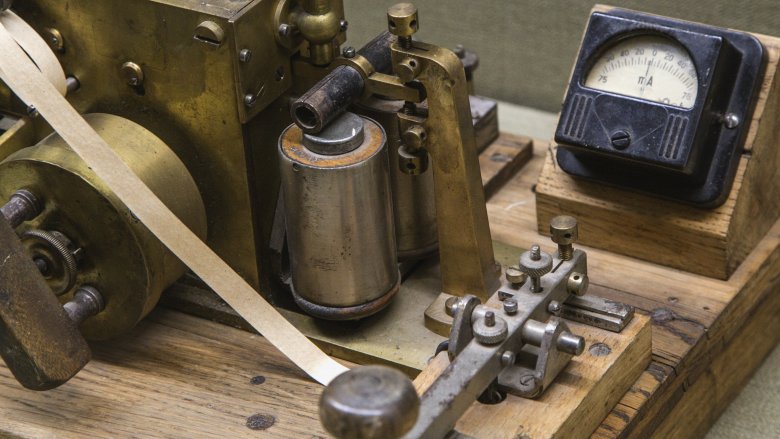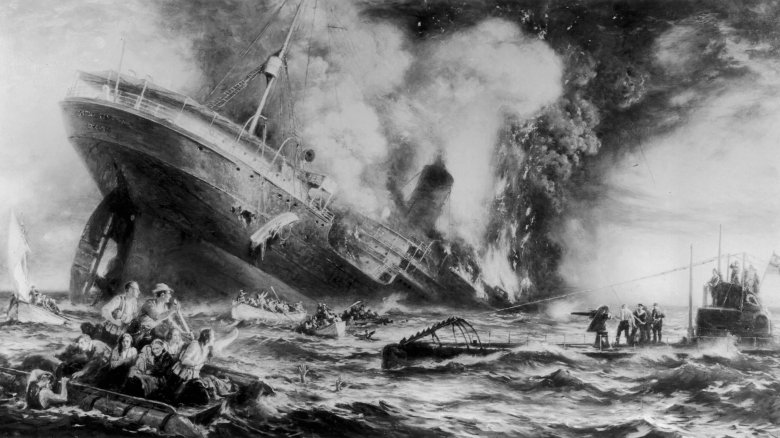The Weirdest Telegrams To Ever Have Been Sent
Telegrams were essentially the precursor to the text message, except it was harder to respond with an emoji. They're not even as old-timey as you might think. In 2013, The Guardian reported the telegram finally went the way of the dodo, the brontosaurus, and AOL when the last one was sent in India. It was the end of an era started when Samuel Morse sent the first telegram on May 25, 1844. (Morse's read, "WHAT HATH GOD WROUGHT?") Between the first and last telegrams there were approximately a gajillion others; among the world-changing and the comically stupid, some were just strange.
The telegrams from 'Mr. Levy'
For most of us, it's a sad fact of life that no one's going to remember your name for too long after you're in the ground. Thanks to a series of telegrams you could describe as weird, audacious, or just insane, the Post & Tele Museum of Denmark still remembers the man who called himself Kommerz-Rath Levy aus Berlin.
He walked into a Copenhagen telegram station on July 8, 1914, and proceeded to send some telegrams. Lots of them, including one to the Danish PM that read, "I WILL STAY AT PALADS HOTEL IN YOUR ESTEEMED COMPANY, TRADE COUNSELLOR LEVY FROM BERLIN, BARON OF DRIESEN, STATE SECRETARY."
Nothing odd to see here, right? Only no one has the foggiest idea who he actually was, least of all the Danish PM. It gets even stranger when you know he sat down at the station and produced telegram after telegram (on a typewriter, because his handwriting was so bad), and every telegram got closer to outright gibberish until it finally crossed the nonsense threshold. Staff ended up calling the police because he wouldn't A) stop writing gibberish telegrams or B) leave. Sadly, he seemed to drop off the face of the earth after he was escorted away. That's a shame because he probably had quite the tale to tell.
Edward Teller sends word of a successful hydrogen bomb test
Edward Teller was dubbed the "father of the hydrogen bomb" by some, and according to The Telegraph, less generous people called him "a war criminal." He was all about using science for military applications, so it's not entirely surprising he was at the forefront of the development of one of the most devastating weapons in the world. Importantly, however, he championed the use of these large-scale weapons even after the horrors of Hiroshima and Nagasaki. While it's rumored that fellow A-bomb papa J. Robert Oppenheimer broke down in tears in front of President Harry Truman, Teller's opinions of the hydrogen bomb were perfectly, eerily summed up by the telegram he sent announcing his first successful test.
According to Building the H Bomb: A Personal History, Teller announced his success to Los Alamos by simply writing, "IT'S A BOY."
The telegram to Mars
While the telegram itself is weird — it read, "OPESTI NIPITIA SECOMBA" — Londonist says the story behind it is even weirder.
Those words aren't gibberish, at least, not according to Dr. Hugh Mansfield Robinson. He sent the telegram on October 27, 1926, to a Martian lady named Oomaruru. She would definitely understand what it meant, which he knew because he'd been communicating with her via a psychic link for some time. Robinson claimed he had first contacted Martians after astrally projecting to the red planet in 1918, when he discovered the race of giant, big-eared, hairy aliens which he also described as having "a Chinese cast of features." His description of their culture was incredibly detailed, and he claimed they had huge airships, used water to power their cities, and employed a less intelligent, walrus-like race to do their manual labor.
Points for creativity. Needless to say, Robinson's Martians never returned his message. He claimed the telegram couldn't get through Mars's "layers of rarified air," so he tried again. The second message read, "MAR LA OI DA EARTH. COM GA MAR," which was supposedly Martian for, "Love to Mars from Earth. God is love." They didn't respond to that, either, but the popular press had a field day when they found out.
The platypus lays eggs
The platypus is still weird. Seriously. Just look at it. Describe that thing to someone who's never seen one, and it sounds like you're pulling someone's leg. It's no wonder that according to the journal BioScience, scientists were arguing about what it was for almost a century. No one had the foggiest idea what it was or how to classify it. The easiest answer was that it was just a hoax. (That theory came from Robert Knox, who is best known today for being a grave-robber.)
The whole saga of the platypus is weird, so it's only appropriate that one of its strangest characteristics — the ability to lay eggs — was announced via telegram in a Latin message reading, "MONOTREMES OVIPAROUS, OVUM MEROBLASTIC." Since telegram prices were determined by the number of words, this was a clever way to pack "these things lay eggs with big yolks kinda like birds do" into a pretty cheap message.
The Earhart telegrams
Just what happened to Amelia Earhart is one of American history's most enduring mysteries. Even though there are a ton of conspiracy theories about what happened, the truth is probably much more mundane. It also may have been covered up for decades.
Kiribati is an island in the Pacific and in 1940, locals found a skull, some other bones, a sextant box, and a woman's Size 10 shoe. That's the sort of thing you should tell people about, but Forbes says a series of telegrams from the Tarawa administrative office to officers on the front lines of settling the islands made it clear they should tell exactly no one. Even as medical personnel examined the remains to try to find out more about the person they belonged to, telegrams flew back and forth.
Fortunately for us, The International Group for Historic Aircraft Recovery got those telegrams, and you can peruse the whole chat log. It starts with one that can't possibly be misinterpreted, reading: "PLEASE OBTAIN FROM KOATA A CERTAIN BOTTLE ALLEGED TO HAVE BEEN FOUND NEAR SKULL DISCOVERED ON GARDNER ISLAND. GRATEFUL YOU RETAIN BOTTLE IN SAFE PLACE FOR PRESENT AND ASK KOATA NOT TO TALK ABOUT SKULL WHICH IS JUST POSSIBLY THAT OF AMELIA EARHARDT (sic)." Dozens of telegrams follow, and they're pretty shocking evidence there was a clear move to suppress any information about the remains. Audacious? Absolutely. Conspiracy? Who knows?
Goering's telegram
When The Washington Post reported on the discovery and sale of a telegram sent to Adolf Hitler by Hermann Goering, they called it "the Nazi telegram that helped drive Hitler to suicide." That's a huge claim. What could possibly be in that 'gram?
In 1941, Hitler formally — but secretly — established Goering as his successor. When things really started going sideways, though, Goering put on his walking shoes and headed deep into the Bavarian Alps, while Hitler hunkered down in front of an advancing Soviet Army. That was when he got the telegram, reading in part (and in German), "I felt obligated to assume, in case by 2200 o'clock no answer is forthcoming, that you have lost your freedom of action. I shall then view the conditions of your decree as fulfilled and take action for the well being of Nation and Fatherland."
In short, Goering was ready to step up. Those in Hitler's company were quick to declare Goering a traitor, and Albert Speer's biography describes the Fuhrer's fury, then depression, and suicide a week later. The telegram is credited as being one of those final straws that broke the camel's back, or in this case, the single piece of paper that broke the already floundering remnants of the Third Reich.
The Titanic distress telegram
Decades later, we're still fascinated by the Titanic. That's probably because there's a lot we don't know about what happened (and still more we wrongly think we know). At the heart of one of the biggest mysteries is a telegram.
After the disaster, there was a huge investigation during which White Star Line head Philip Franklin swore he hadn't gotten any distress calls. And there was no evidence to the contrary until 2015.
The telegram read, "WE HAVE STRUCK AN ICEBERG = SINKING FAST = COME TO OUR ASSISTANCE," and it was found in an envelope dated 1998, along with a note promising the message was 86 years old. A close examination of the paper, ink, and type seems to indicate that it was authentic, but Atlas Obscura says there are just as many questions as answers. Did Franklin know about the telegram and cover it up? Or did this incredibly urgent message just get dumped into someone's mail pile along with other telegrams selling the latest miracle weight-loss pill or baldness cure? Would it have changed anything if we'd known about it sooner? We have no idea, and probably never will.
Tipsy telegrams
Plenty of telegrams use codes of one sort or another, but leading up to the outbreak of World War I, Australia had some really odd code words in place. The State Records Office of Western Australia says codes were used for everything from shipping and commercial operations to military concerns, and on August 5, 1914, they received a telegram that was much more serious than it seemed at first glance.
It simply read, "TIPSIFIED GERMANY. GLYPHIC." It was code for something not nearly as awesome as having enough drinks to make you feel really, really good. It decoded as: "War has broken out between Great Britain and Germany. Signed, the Governor General." Heavy stuff in just three words.
It wasn't the only time "TIPSIFIED" was used as a code for war, either. On November 6, 1914, another telegram was sent reading, "TIPSIFIED AND TURKEY, GLYPTICA." That one referred to a declaration of war between Britain and Turkey, which is not the best kind of booze-soaked turkey you can imagine.
The last telegram from Percy Fawcett
By the time Percy Fawcett set off on his last expedition, he was already well established as an explorer. He had mapped out huge areas of the Amazon rain forest in the early 20th century, and along the way, he discovered stories and clues he thought confirmed the existence of a long-lost civilization he called the "City of Z." The only thing he didn't have was a location, and according to author David Grann (via History Extra), that's what he set out to find in 1925.
Even at the time, no one really believed there was some amazing, lost civilization just waiting for friendly European adventurers to come knocking. Fawcett was convinced, though, and headed out with his son Jack and Jack's friend Raleigh Rimmell. Again. He'd tried it before with no luck, and this time, he was going roughly 1,000 miles into the largely uncharted Amazon interior. After one final communication, they were never heard from again.
It's that last little bit of information that makes his final telegram as unsettling as it is. Fawcett's wife, Nina, received the optimistic telegram on May 29, and it read, "I EXPECT TO BE IN TOUCH WITH THE OLD CIVILISATION WITHIN A MONTH ... YOU NEED NOT HAVE ANY FEAR OF FAILURE." You never know what your last words might be.
Sinking the Lusitania
Alfred Vanderbilt was one of those Vanderbilts, and he was on board the Lusitania when it was torpedoed in 1915. His life was surrounded by all the juicy scandals you might expect, but according to The Lusitania Resource, he redeemed himself in the end by giving his life jacket to another passenger and condemning himself to the cold ocean waters. According to the book Codebreakers, he had every reason not to be on the ship in the first place.
First, a bit of weirdness. Vanderbilt was supposed to have been on the Titanic when it sank, but he'd canceled his plans at the last minute. It was so last-minute, in fact, that he was still on the roster of passengers and was originally reported among the dead. When it came time for him to set sail on the Lusitania, he — and eight others — received an odd telegram that read, "THE LUSITANIA IS DOOMED. DO NOT SAIL ON HER. MORTE."
The military knew the Lusitania was a potential military target, but Vanderbilt shrugged the telegram off as a morbid joke. You can see how, given his history with the Titanic, he'd think that. Unfortunately for him, the Germans weren't in on the joke.










